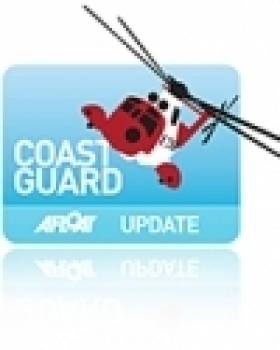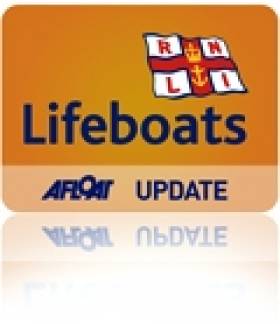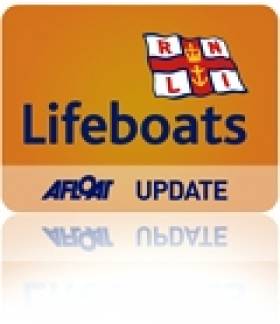Displaying items by tag: Coast Guard
Warning Issued as Logs Fall from Vessel off South East Coast
The Waterford-based Coast Guard helicopter has already investigated and some of the cargo has washed up on the south east coast. The vessel was on passage from Portavogie (Scotland) to Youghal, when the incident occurred.
Weather conditions in the area are winds south westerly force 5/6 with moderate visibility. A navigation warning has been issued to vessels in the area.
Crosshaven Lifeboat Rescues Crew from Sinking Fishing Vessel
At 11.19am , Valentia Coast Guard alerted Crosshaven RNLI Lifeboat that the fishing vessel was in serious trouble off the Church Bay area and requested an immediate launch. Crosshaven lifeboat launched within 5 minutes and with its volunteer crew of Kieran Coniry, Dan O'Donoghue and Vincent Fleming, made good progress through a two metre sea swell arriving on scene to find the fishing boat had at this stage sank and the crew safely in the Liferaft.
The Ballycotton RNLI all weather Lifeboat was at sea on exercise at the time and immediately altered course to the incident. Crosshaven Coast Guard were also tasked and en route.
When it became clear that the two crewmen were safely aboard the Crosshaven Lifeboat, the other emergency services were stood down. Crosshaven Lifeboat then brought the two fishermen back to Crosshaven.
While it is unknown what caused the fishing boat to flounder, the crew had little time to deploy their liferaft and make an emergency call before the boat sank.
Related Safety posts
RNLI Lifeboats in Ireland
Safety News
Rescue News from RNLI Lifeboats in Ireland
Coast Guard News from Ireland
Water Safety News from Ireland
Marine Casualty Investigation Board News
Marine Warnings
Giant Prowler Wave Location Remains Secret
According to a Press Association report one of the six-man team, Briton Andrew Cotton, first spotted it several years ago while on board an Irish Coast Guard helicopter after being rescued from a surf accident off Mullaghmore, Co Sligo.
Last night some west coast surfers told Afloat.ie the location is most likely off the Sligo coast, up to two kilometres offshore and close to an underwater reef.
The terrifying-looking wave, dubbed 'Prowlers', was reportedly up to 50ft high on Tuesday when the Irish, British, Australian and South African surfers ventured out. Photos of it appeared on the front page of the Irish Times yesterday.
The surf team included Bundoran's Richie Fitzgerald who says he had waited for five years for the type of conditions required to surf it and on Monday the waves were in the 40-50ft range. Conditions were perfect due to the massive swell generated by Hurricane Tomas.
Ballycotton Lifeboat Launches for Pleasure Craft in Choppy Seas
Ballycotton RNLI lifeboat was launched at 12:10 today for a pleasure craft in the Ballycotton Bay area of East Cork.
No contact had been made with the lone sailor for over an hour and his concerned family contacted the Coast Guard.
Sea conditions in the area was choppy at the time, with the wind blowing North East force 6/7.
The Ballycotton RNLI lifeboat, Austin Lidbury, were requested to launch, as were the Ballycotton Coast Guard unit and the Waterford based Coast Guard helicopter, Rescue 117.
The pleasure craft returned safely to shore under its own power shortly afterwards and the emergency units were stood down.
Related Safety posts
RNLI Lifeboats in Ireland
Safety News
Rescue News from RNLI Lifeboats in Ireland
Coast Guard News from Ireland
Water Safety News from Ireland
Marine Casualty Investigation Board News
Marine Warnings
Investigators Praise Pilot Who Ditched Into Irish Sea
The pilot of a light aircraft that ditched into the Irish Sea last year has been commended for his flying skills and quick thinking after taking the plane down safely.
John O'Shaughnessy was flying the two-seater plane from Wales to Wexford on 11 August last year when the accident occurred off Tuskar Rock, just 15 minutes away from his destination.
He executed a 'belly landing' and was spotted by a nearby ocean rowing team who came to his aid before the Coast Guard arrived.
On Wednesday (13 October) the official investigation into the incident found that engine failure was to blame and not pilot error. However, accident investigators also found that the standard pre-flight checks were not fully carried out.
The report praised O'Shaugnessy's actions in ditching the plane "despite the fact that he was not particularly familiar with the aircraft".
Investigators said that the engine failure was "probably due to fuel starvation relating to a fuel-vapour related problem". They also noted the lack of a flight plan for O'Shaughnessy's journey.
Man Dragged from Capsized Dinghy at Newtownards Sailing Club
At around 11.45 this morning Belfast Coastguard received an urgent call for assistance to the Newtownards sailing club where four people were in difficulty, two of them children. One man is unconscious, and in a poor way.
An upside down Lazer 2000 dinghy was spotted by a sailing instructor who went to render assistance to those in the water. The crew of a further incoming rigid inflatable boat also helped.
A man in his 50s was then pulled from the water and brought ashore. He is in a very poor way and cardio pulmonary resuscitation has been administered both in the incoming vessel and ashore. The second adult who had been in the upturned dinghy also assisted. Two children who were also in the water are cold, wet and in a state of shock but otherwise unharmed. All four were wearing lifejackets but the lifejacket on the casualty did not inflate.
The Portaferry inshore lifeboats were launched plus the Bangor Coastguard Rescue Team attended. Local police were also in attendance. An ambulance is also on scene.
Rob Steventon, Watch Manager at Belfast Coastguard said
"Along with the Police we are still gathering further details, but we do not know as yet how long the dinghy had been upturned or how long they had been in the water as the first report was by someone who was going out on to the water and had seen the hull of the craft.
"We urge boaters strongly to check their life saving equipment and general safety equipment to ensure everything is working correctly. The Marine Accident Investigation Branch has been informed."

































































